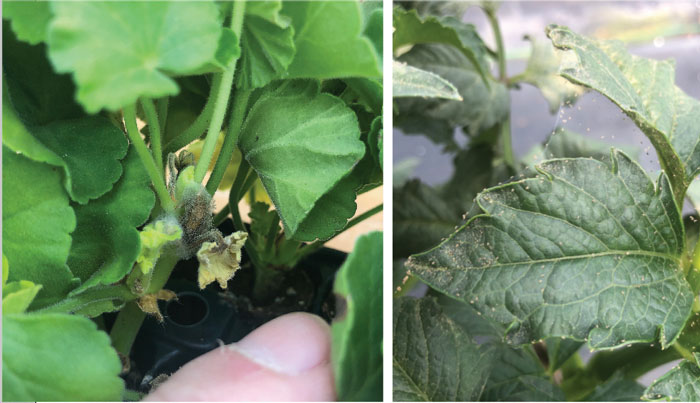10/1/2020
I Can’t Resist
Paul Pilon

There are so many tempting things in life, like a good cheesecake, that’s hard for me to resist. Unfortunately, I’m not going to be talking about life’s greatest temptations here. Rather, I’ll be focusing on insect and disease resistance in this article.
Why? It’s very important for one. Consider how many times you’ve read an article or attended a presentation (in case you forgot, there once was a time when people attended these primitive, in-person versions of what’s now known as webinars today) where the author or presenter mentioned resistance management or rotating pesticides. Growers and applicators even run across verbiage on pesticide labels referring to resistance management. Believe me, resistance management wouldn’t be in these places if it weren’t important.
Resistance management is a pretty intense topic with various viewpoints and approaches. It’s a subject that can easily fill up this entire magazine. Rather than doing that, I’m going to make an attempt at covering the topic in the next 800 words or so. Ready? Let’s get into it.
First, the basics
Chemical pesticides are divided into various classes depending on the type of pest they’re effective at controlling. For example, fungicides are used to control plant pathogens, insecticides for controlling insect pests, and miticides are effective at managing various types of mites. Unfortunately, many pests and diseases are capable of developing resistance to many of the pesticides growers use to control them.
Pesticides are usually most effective at controlling a pest when they’re applied to a particular life cycle or stage of development of an insect or disease. The application of these products to non-responsive life stages results in less overall control of the targeted pest or disease. The greatest level of control is obtained when growers pick pesticides that are appropriate for controlling the desired pests and apply them to the life stages that will yield the greatest results.
Today’s growers need to be concerned about pests building up resistance to the chemicals being applied to control them. Pest biology, the intensity of past and present pesticide applications, and commercial production practices are all contributing factors leading to resistance in pest and disease organisms.
What leads to resistance?
The method pesticides control or act against the living systems of the pest is referred to as the mode of action. Each pesticide is classified by its mode of action and products that share a common mode of action belong to the same chemical class (also referred to as chemical family). Once a pest develops resistance to a specific pesticide, it’s usually resistant to other (if not all) of the products within that chemical class.
 Pictured far left: Many diseases, such as the Botrytis on this geranium, can develop resistance to fungicides when chemical rotations aren’t implemented.
Pictured far left: Many diseases, such as the Botrytis on this geranium, can develop resistance to fungicides when chemical rotations aren’t implemented.
Pictured left: Spider mites and insect pests can easily develop resistance to control products when they’re applied or rotated improperly.
Insects or diseases are more likely to develop resistance to applications containing a single mode of action. Therefore, it’s less likely for pests or diseases to develop resistance when pesticides or combinations of them containing multiple modes of action are applied. Over time, growers shouldn’t rely on a single pesticide to control a particular pest or disease.
Applicators should know the mode of action and chemical family for each pesticide they apply. This information is extremely helpful for picking alternate chemicals to rotate with or when designing preventative programs.
Preventing resistance
The first step to reducing potential pest resistance is to reduce the reliance on synthetic pesticides. When and where possible, try to use non-chemical methods of controlling pests, such as implementing cultural, mechanical, physical and biological management options. There are lots of viable non-traditional control options out there. In most cases, pests and diseases don’t or can’t develop resistance to bioinsecticides, biofungicides and beneficial insects.
Determining when and how to rotate synthetic pesticides is an essential consideration for resistance management. One commonly used approach entails using one product throughout one generation or life cycle of the pest. With overlapping populations containing all life stages, this approach may result in the same pesticide being applied for two or three subsequent applications before rotating to a product with a different mode of action. A second (and my preferred approach) is to use products from different chemical families and having differing modes of action with each application.
There are a couple other considerations I’d like to pass along. Using combination products or tank mixes containing different modes of action usually results in good control and is a sound resistance management strategy. For managing resistance, the best chemicals are those that work quickly after the application and disappear rapidly from the crop area; this reduces the length of time the pests are exposed to these products. Pesticides that are long lasting or degrade slowly over time, often only kill the most susceptible portion of the pest population and leave behind the resistant pests, which reproduce an even more resistant pest population.
161 words to go …
In my attempt to cover resistance management in just 600 words, it’s time to wrap up with the final 161 words (give or take).
Resistance management should be an upfront and ongoing consideration when determining how to best manage pests and diseases. Growers should follow good sanitation and cultural practices, use biopesticides and beneficial approaches when possible, utilize effective pesticides at their labeled rates, apply pest control products to the appropriate life stages they effectively control, rotate between products with differing modes of action, only apply these products when necessary, and minimize the number of applications being applied to each crop.
Failure to practice good resistance management strategies will result in inadequate levels of control, increases the use and costs of pesticide, and may adversely affect the quality and marketability of the crops being produced. GT
Additional information regarding resistance management and tables containing pesticide mode of actions can be obtained from the following websites: For insecticide resistance and mode of action—irac-online.org/mode-of-action—and for fungicide resistance and mode of action—frac.info/fungicide-resistance-management.
Paul Pilon is a Perennial Production Consultant and editor-at-large of the Perennial Pulse e-newsletter. Feel free to contact him with article topics or to address your perennial production challenges. He can be reached at paul@perennialsolutions.com.